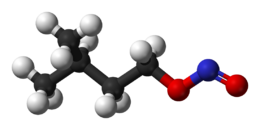 | |
 | |
| Clinical data | |
|---|---|
| Other names | Isoamyl nitrite, Isopentyl nitrite, Nitramyl, 3-methyl-1-nitrosooxybutane, Pentyl alcohol nitrite (ambiguous), poppers (ambiguous, colloquial, slang) |
| ATC code | |
| Legal status | |
| Legal status |
|
| Identifiers | |
| |
| CAS Number | |
| PubChem CID | |
| DrugBank | |
| ChemSpider | |
| UNII | |
| KEGG | |
| ChEBI | |
| CompTox Dashboard (EPA) | |
| Chemical and physical data | |
| Formula | C5H11NO2 |
| Molar mass | 117.148 g·mol−1 |
| 3D model (JSmol) | |
| Density | 0.872 g/cm3 |
| Boiling point | 99 °C (210 °F) |
| Solubility in water | Slightly soluble mg/mL (20 °C) |
| |
| |
| (verify) | |
Amyl nitrite is a chemical compound with the formula C5H11ONO. A variety of isomers are known, but they all feature an amyl group attached to the nitrite functional group. The alkyl group (the amyl in this case) is unreactive and the chemical and biological properties are mainly due to the nitrite group. Like other alkyl nitrites, amyl nitrite is bioactive in mammals, being a vasodilator, which is the basis of its use as a prescription medicine.[1] As an inhalant, it also has a psychoactive effect, which has led to its recreational use, with its smell being described as that of old socks or dirty feet.[2] It was first documented in 1844 and came into medical use in 1867.[3]
- ^ "Amyl Nitrite (Inhalation Route) Description and Brand Names - Mayo Clinic". www.mayoclinic.org. Retrieved 2023-12-05.
- ^ "Drugs - Amyl, Butyl or Isobutyl Nitrite, Nitrates, Poppers". urban75.com.
- ^ Fischer J, Ganellin CR (2006). Analogue-based Drug Discovery. John Wiley & Sons. p. XXX. ISBN 9783527607495.